Just a guy who somehow has himself deep digging into video games to find out as many relevant breakthroughs as thinkable :)...( might also be debunking the so-said "cOmMoN kNoLeDgE" of some gamers ツ )
Don't wanna be here? Send us removal request.
Text
Alright so as much as I like fanarts and all the trailblazing ZTotK drawings, I still see people coming back and forth with those random 4'11 & 5'2" heights for Link in Tears of the kingdom.
On top of that I still haven't seen any proof of those statements.
But that got me thinking back my process to find Link's height in TotK.The ideal case would be to find it out with the least amount of hypothesis and assumptions to get as humanly close to the truth as possible.
In my last post the only assumption used was "1 coordinate distance unit is equivalent to one meter" which I by that time had trouble to prove it :(
However, after a little bit more experience and time into the game I stumbled upon the most interesting mini-game :)
Let me introduce to you the Ultra Ball Haul !
THAT mini-game itself helped me figure out a lot when it comes to in-game measurements.
I don't want this repost to be longer than the Great wall of China again so I'll try to keep it quick.
Basically the mini-game provides a real life measurement unit (meters).With that in mind we can easily prove that one meter is indeed equivalent to one coordinate distance unit (trust me it's easy to demonstrate I did it multiple times and checked it many times meaning you can too).
Then knowing the 21 max item entanglement limit, we can set up a way of measuring height of objects as I explained through this vid (do not take the height results because one measurement threshold isn't enough, just get to understand how I use the mini-game for measuring heights) :
youtube
Now we could be looking for something which is practically as tall as Link and after a bit of research a flux construct block seems to be almost the same height (it's in fact a tad taller than Link).

In the real world, macroscopic objects/creatures are measured to a centimeter accuracy so to get a such accuracy we want to measure a set of 10 construct blocks :
youtube
Thus we can see that one of these blocks looks to be 1.80 meters tall (about 5'11" & 1/2")which means Link is around that height.
Using a careful Link measurement set up we can finally get a True (with no assumption used unlike many others' so said calculations) in-game reference height for Link :
youtube
So after several checking the question is finally answered in TotK, Link is 1.76 meters (5'9" & 1/3").
My old calculations aren't necessarily wrong since the 1.76 m result finds itself within the old uncertainty range but that mini-game (Ultra ball haul) seriously improved my measurements' accuracy.
I don't know why almost no one ever mentions this mini-game for stuff like this topic (It's like nobody could see that mini game).
Anyways, I just wanted to correct myself and improve what was improvable but this is my last (re)post on this topic.
All in all, Link is a little above the men's average height in the USA for reference and Hyrule in Tears of the kingdom is just ginormous as well as its various inhabitants all species included.
Also for the sussy bakas (I didn't forget them lol), please stop using that outdated untrue 5'2" result from BotW mindlessly (it's proven ridiculously wrong by TotK's standards).
Either way keep safe everyone ;)
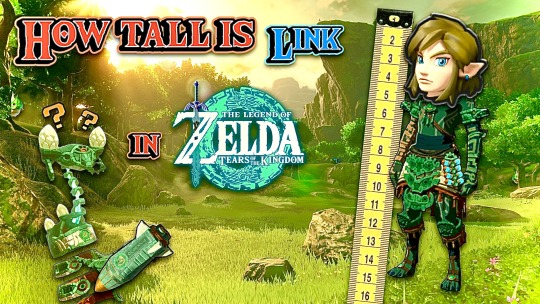
How tall is Link in Zelda Tears Of The Kingdom ?
This topic is always what most players wonder when playing a (new) Zelda game especially when Link looks shorter than almost every NPCs and entities.
But what surprises me the most is that many people in the community assume he is the same height as in ZBOTW or claim to have figured out his height based off of ZBOTW without elaborating much somehow which isn't satisfying at all.
We want to know Link's height in ZTOTK based off of ZTOTK information and tools.
What we want to be looking into at first is Link's canon height.Unfortunately, speaking to NPCs/reading diaries/looking for something's or someone's canon height didn't provide any type of canon reference to figure out Link's canon height (unlike in Breath of the Wild where a gerudo named Deltan stated she was 8 feet tall).
As a result we are going to work out Link's height using in-game measurements, to do so we'll manipulate the in-game coordinates :
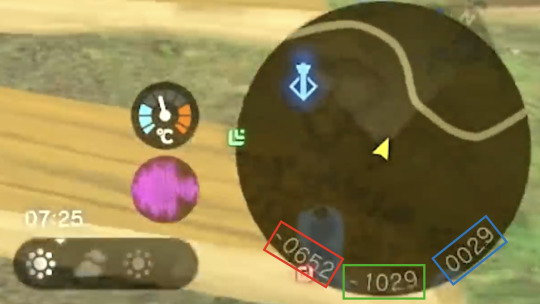
These are important to calculate distances as well as measuring Link in those distance units.
It has been established for a while now that one distance unit displayed in the coordinates is equivalent to one meter.It is quite difficult to back up this statement but when talking to NPCs, those who quantify distances generally come up with the metric unit (I don't have a screenshot for proving it but if you talk to a brown skin traveler with an afro haircut and a rabbit shield in the French version of the game, he comes up with the metric unit at some point).
With that assumption in mind let's start off by looking for a reference (i.e: an object or something which will be used to determine Link's height), a wooden crate seems to be good one as we can approach its model with a cube on top of being experimentable on flat surfaces.
Now the idea is to approximate a wooden crate's height and to do it we have to measure many crates on top of each other with the altitude coordinate :
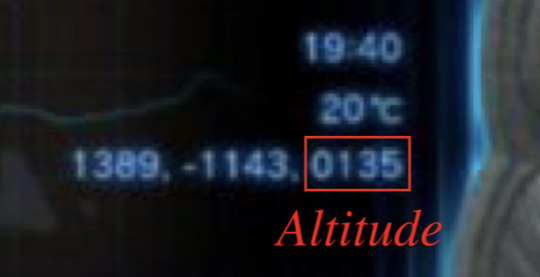
We could've measured 100 crates merged all together but the game reFUSEs to fuse more than 21 items together (I learnt it the hard way after spending around 600-ish zonaites to make sure the tests go right in any case) :

Ultimately 20 blocks were measured successfully on a flat surface in a maze so here are the altitude coordinate values at the surface level and at the 20th wooden crate level respectively :

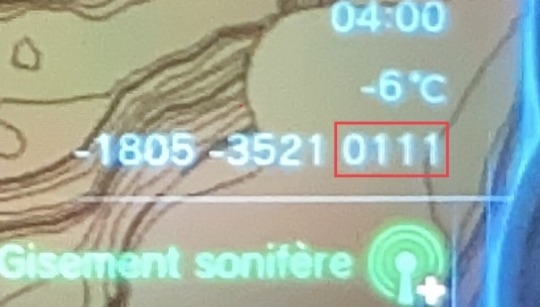
Subtracting both coordinate values (111-71) we find out 20 crates are about 40 meters tall meaning that a crate is about 2 meters tall.
Then we can figure out Link's height by measuring him next to a crate.However in order to avoid any parallax issue we are going to locate a specific part of the wooden crate the top of Link's head reaches with a sample of screenshots from different angles :
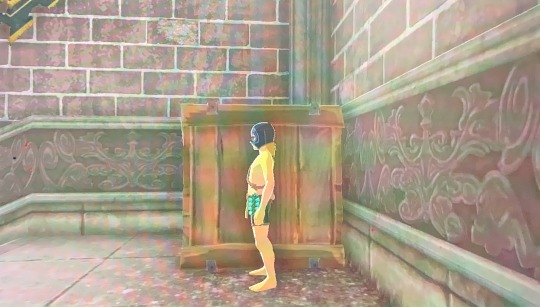
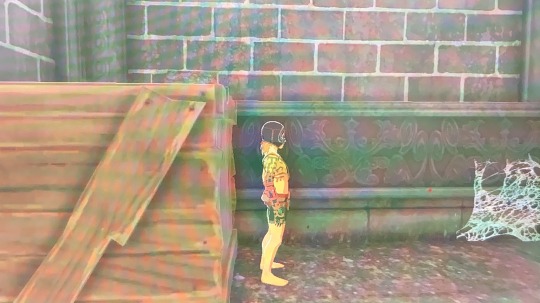
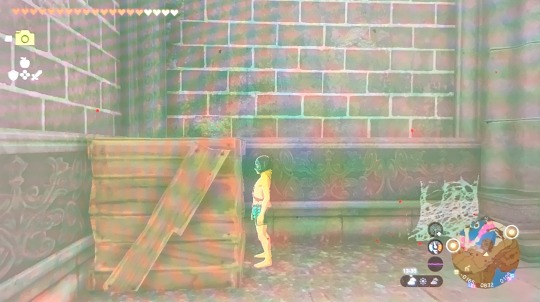
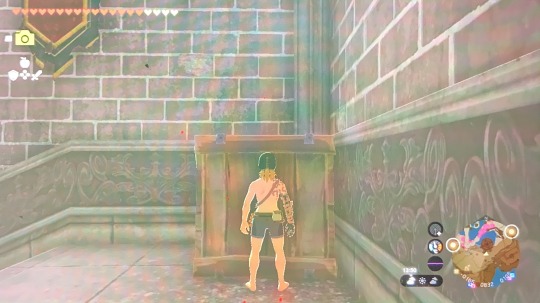
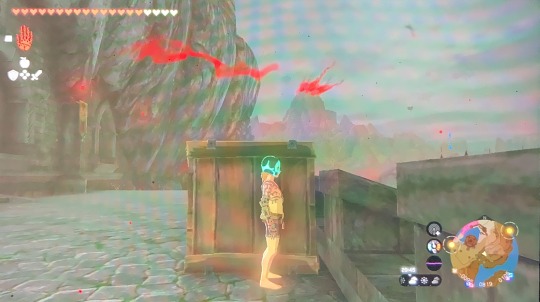

(I took many more angles but to not overload this post we'll keep these 6 photos as a simple sample)
Thereafter, we can figure out the specific crate's portion the top of Link's head reaches (blue line) :
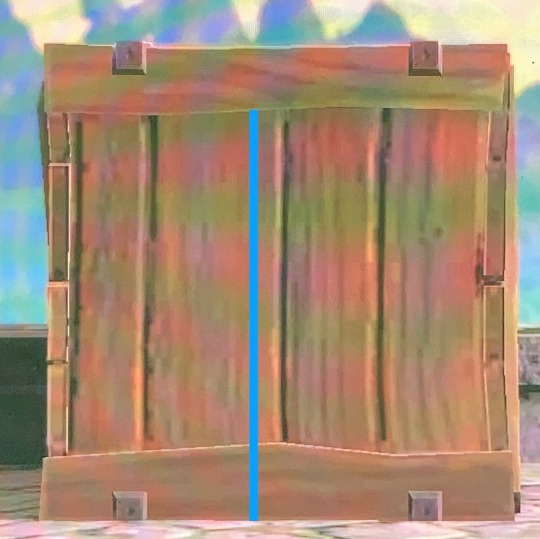
Finally we can calculate Link's height using some proportionality and pixel measurements :
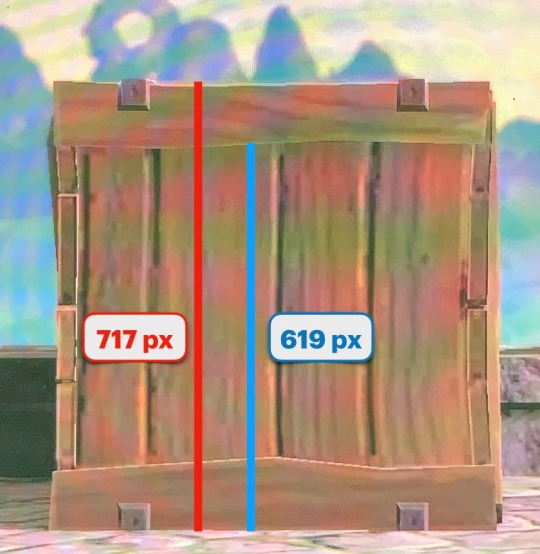

Therefore Link is roughly 1.73 (5'8")meters tall, he is actually taller than 5'2" (1.58 m), still not surprising.
I smell sussy bakas coming up with Bread pirate's video from miles away so let me explain why the 5'2" is sort of wrong when it comes to Link's height in BOTW :
If we take a close look at where link is placed next to the metal box, we can see there is a parallax issue (i.e: the change in the apparent position of the metal box relative to Link being more distant, caused by the change in the picture's line of sight towards both Link and the metal box) which means Link is taller than what he was measured previously in BOTW :
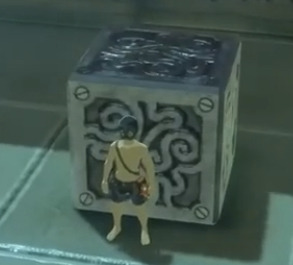

Hereafter seem to be the specific part of the metal box the top of Link's head reaches in BOTW :
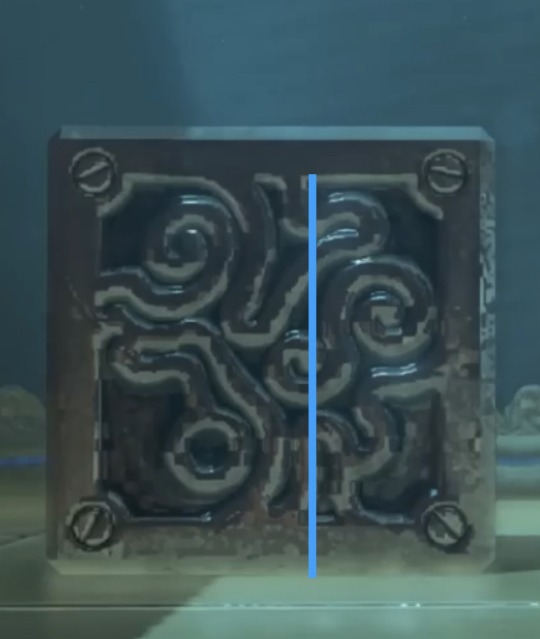
Thus recalculating Link's height in BOTW following Bread Pirate's method without the parallax issue suggests that Link is around 1.78 meters (5'10") :
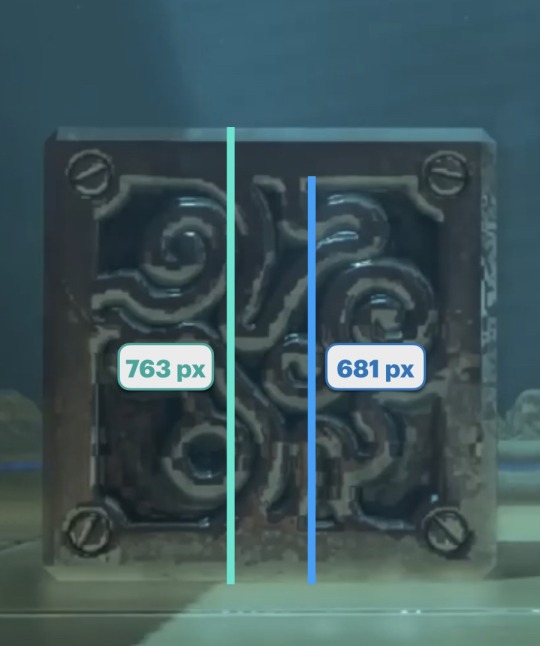

Basically BOTW Link & TOTK Link are practically about the same height (5 centimeters are a little negligible in the game) empirically which in some way confirm "the not changed height" and why we could feel like Link is as tall in TOTK as in BOTW.
Now for more interpretations regarding other entities/NPCs in comparison to Link, I advice you to see this post :
Sidenote: Furthermore, taking errors and uncertainties into account we can find a range in which Link's true height in Tears of the Kingdom is included.
About the altitude coordinates we measured, those values are rounded up without shown decimal places which means that the first 71 altitude coordinate value actually ranges from 70.5 to 71.4 and that the second 111 altitude coordinate value ranges from 110.5 to 111.4 :
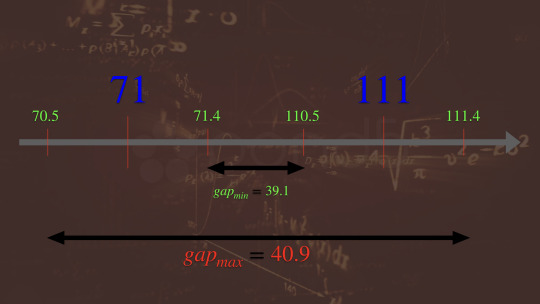
Besides, to find the uncertainty related to a wooden crate's height we determine the difference between the minimum gap/maximum gap and the rounded value found.Knowing that rounded value was 40 m then we get a 0.9 m variation from that value for the height of 20 crates implying the uncertainty of a single wooden crate's height would be 2 m ± 0.045 m.
As for the pixel measurements, it is generally one pixel variation for a numerical measurement tool such as in image editors.
So calculating the overall uncertainty for TOTK Link's height gives a height value ranging from 1.67 m (5'6") to 1.78 m (5'10"):
Link's height = 1.73 m ± 0.06 m
#Youtube#deep dive#deep thinking#gaming#video games#nintendo#zelda tears of the kingdom#ztotk#totk thoughts#totk#totk link#how tall is link in tears of the kingdom#totk link height#link's height#reboot#short king#but well tall in real life#link
52 notes
·
View notes
Text

How tall is Link in Zelda Tears Of The Kingdom ?
This topic is always what most players wonder when playing a (new) Zelda game especially when Link looks shorter than almost every NPCs and entities.
But what surprises me the most is that many people in the community assume he is the same height as in ZBOTW or claim to have figured out his height based off of ZBOTW without elaborating much somehow which isn't satisfying at all.
We want to know Link's height in ZTOTK based off of ZTOTK information and tools.
What we want to be looking into at first is Link's canon height.Unfortunately, speaking to NPCs/reading diaries/looking for something's or someone's canon height didn't provide any type of canon reference to figure out Link's canon height (unlike in Breath of the Wild where a gerudo named Deltan stated she was 8 feet tall).
As a result we are going to work out Link's height using in-game measurements, to do so we'll manipulate the in-game coordinates :

These are important to calculate distances as well as measuring Link in those distance units.
It has been established for a while now that one distance unit displayed in the coordinates is equivalent to one meter.It is quite difficult to back up this statement but when talking to NPCs, those who quantify distances generally come up with the metric unit (I don't have a screenshot for proving it but if you talk to a brown skin traveler with an afro haircut and a rabbit shield in the French version of the game, he comes up with the metric unit at some point).
With that assumption in mind let's start off by looking for a reference (i.e: an object or something which will be used to determine Link's height), a wooden crate seems to be good one as we can approach its model with a cube on top of being experimentable on flat surfaces.
Now the idea is to approximate a wooden crate's height and to do it we have to measure many crates on top of each other with the altitude coordinate :

We could've measured 100 crates merged all together but the game reFUSEs to fuse more than 21 items together (I learnt it the hard way after spending around 600-ish zonaites to make sure the tests go right in any case) :

Ultimately 20 blocks were measured successfully on a flat surface in a maze so here are the altitude coordinate values at the surface level and at the 20th wooden crate level respectively :


Subtracting both coordinate values (111-71) we find out 20 crates are about 40 meters tall meaning that a crate is about 2 meters tall.
Then we can figure out Link's height by measuring him next to a crate.However in order to avoid any parallax issue we are going to locate a specific part of the wooden crate the top of Link's head reaches with a sample of screenshots from different angles :






(I took many more angles but to not overload this post we'll keep these 6 photos as a simple sample)
Thereafter, we can figure out the specific crate's portion the top of Link's head reaches (blue line) :

Finally we can calculate Link's height using some proportionality and pixel measurements :


Therefore Link is roughly 1.73 (5'8")meters tall, he is actually taller than 5'2" (1.58 m), still not surprising.
I smell sussy bakas coming up with Bread pirate's video from miles away so let me explain why the 5'2" is sort of wrong when it comes to Link's height in BOTW :
If we take a close look at where link is placed next to the metal box, we can see there is a parallax issue (i.e: the change in the apparent position of the metal box relative to Link being more distant, caused by the change in the picture's line of sight towards both Link and the metal box) which means Link is taller than what he was measured previously in BOTW :


Hereafter seem to be the specific part of the metal box the top of Link's head reaches in BOTW :

Thus recalculating Link's height in BOTW following Bread Pirate's method without the parallax issue suggests that Link is around 1.78 meters (5'10") :


Basically BOTW Link & TOTK Link are practically about the same height (5 centimeters are a little negligible in the game) empirically which in some way confirm "the not changed height" and why we could feel like Link is as tall in TOTK as in BOTW.
Now for more interpretations regarding other entities/NPCs in comparison to Link, I advice you to see this post :
Sidenote: Furthermore, taking errors and uncertainties into account we can find a range in which Link's true height in Tears of the Kingdom is included.
About the altitude coordinates we measured, those values are rounded up without shown decimal places which means that the first 71 altitude coordinate value actually ranges from 70.5 to 71.4 and that the second 111 altitude coordinate value ranges from 110.5 to 111.4 :

Besides, to find the uncertainty related to a wooden crate's height we determine the difference between the minimum gap/maximum gap and the rounded value found.Knowing that rounded value was 40 m then we get a 0.9 m variation from that value for the height of 20 crates implying the uncertainty of a single wooden crate's height would be 2 m ± 0.045 m.
As for the pixel measurements, it is generally one pixel variation for a numerical measurement tool such as in image editors.
So calculating the overall uncertainty for TOTK Link's height gives a height value ranging from 1.67 m (5'6") to 1.78 m (5'10"):
Link's height = 1.73 m ± 0.06 m
#how tall is link in tears of the kingdom#Link's height totk#Link's height#zelda tears of the kingdom#ztotk#totk#loz totk#loz tears of the kingdom#totk link#height#Link not so short after all#zeldablr#legend of zelda#zelda#tloz#link totk#loz#gaming#video games#math#maths#nintendo#what is link's height in zelda tears of the kingdom ?#Is link short ?#How tall is link in totk ?
52 notes
·
View notes
Text

How can we possibly model acceleration in Mario Kart 8 Deluxe ?
Basically we want to visualise acceleration (i.e: to see how speed changes over time).We could visualise it through a speedometer but there hasn't been any one displayed in-game anymore since Mario Kart Double Dash.
That means we have to find another way to do it, what about actually creating & simulating one with some datas :)
However, modeling the speed of a vehicle while cornering/drifting/boosting/braking/etc.. is clearly a lot of work so we are only going to put effort in modeling a vehicle driving from no speed at all to maximum speed on a straight line (with no direction change not to mess with angular velocity).
First & foremost, long story short acceleration often is often refered as the rate of change of the velocity of an object with respect to time.
Subsequently, in regard to acceleration & relative acceleration in Mario Kart 8 Deluxe, here some summarized piece of information based on the Super Mario Wiki related topic in various Mario Kart games :
How quickly the vehicle's top speed is achieved from a non-moving position. Negatively correlated with speed.
How much the relative speed of the vehicle, i.e. the speed expressed as fraction of the top speed, increases over time.
The time the kart's top speed is achieved when accelerating.
How quickly a kart can achieve its top speed.
The rate of speed increase when holding the acceleration button.
Relative acceleration, i.e. how much the fraction of current speed to maximum speed increases over time.
Increase in absolute speed per frame, i.e. the amount of distance units/frame that can be added to the current speed in each frame.
In those wikis, speed is generally expressed in distance units per frame, a frame being a time unit (which depends on framerate) proportional to the usual & conventional time units (in MK8DX since the game runs at 60 fps thus we'll assume 60 frames equate a second).
Also the aforementioned relative acceleration (not to be confused with acceleration itself which is sometimes specified as effective acceleration) refers to the acceleration experienced by one object with respect to another object or reference frame (the relative acceleration between the two objects is the acceleration one object would observe when measuring the motion of the other object from its own frame of reference).
As we more or less have got an idea of acceleration purpose in Mario Kart 8 Deluxe, let's focus on what has been stated around it in the in-game stats wiki :
Technically, to model acceleration the best intuition to get would be to look for a mathematical function describing vehicles' accelerations patterns throughout the game's code.Unfortunately, most players like me do not have access to anything like that or do not know how to get that.
Nonetheless, instead of looking for a mathematical function, we may in fact consider looking for a mathematical (recursive) sequence :p
You know generally race vehicles gain much more speed at the start of driving than at the end when they are about to hit top speed, this something we notice too when driving regular cars for example.That suggests the speed increases faster while driving at low speed, in this case the lower the speed the greater the acceleration.
We could associate acceleration as a speed increment and consider that while driving the next speed value at a given frame is the current speed value plus a speed increment.
I see some people coming with the old goofy acceleration formula below :

Using the relative accelerations' values in that formula would be wrong in the way it'd confuse effective acceleration with relative acceleration on top of assuming the overall acceleration at any given frame is constant meaning the speed increment is constant as well which is not the case we just thought over.
Anyways, let's dive into the following quote from the MK8DX in-game wiki :
How much the fraction of current speed to maximum speed increases over time.
From what we said our sequence should like this :

( "nth", "umpteenth".. same to me, thank you in advance for not arguing on one of these with me :? )
That something is indeed acceleration (effective acceleration) since it is related to the speed increments.
In the quote, with the word "fraction" we have to think of a portion instead of a quite literal fraction which would in our case may represent the difference between maximum speed and current speed (subtraction) since the initial value of the sequence is Vo = 0 (distance units/frame), a fraction would create a sequence with every value being 0 which does not make any sense (the vehicle is basically not moving at all at this point) :

Note that this subtraction makes sense as the value decreases over time just like speed increments should, then the "increases over time" art of the quote only suggests that as current speed increases over time it implies the literal fraction of current speed to max speed also increases over time which makes sens too but do not necessarily neglect the "max speed - current speed" subtraction's decrease over time.
Obviously the quote aims to explain in some way the relative acceleration but we are going to use its pattern to illustrate effective acceleration because (correct me if I happen to be wrong here) relative should somehow be proportional to effective acceleration.
Now if relative acceleration is proportional to effective acceleration then relative acceleration should affect the subtraction of current speed to max speed :

Normally, we obtain a pretty interesting basic sequence to quantitatively model speed while accelerating from a full stop :

We can also specify the sequence mathematically as being an arithmetico-geometric sequence :

Following the logic of the obtained sequence the speed increments actually decreases over time which is while accelerating which is what we expect.
Now let's check out whether the sequence is reliable for an in-game perspective or not.
To test the sequence's viability, we want to record the time it takes for a given combination to go from 0 to top speed (in 150cc).We can pick the following combination for instance :

Doing quick equations we found out the levels of both speed (ground speed in our small study) and acceleration being 12 & 12 respectively :p
So here are their related values provided by the wiki for the variables our sequence accounts for :

Besides, we will do the experiment on the straightaway from the N64 Yoshi Valley track :
youtube
As for the experiment itself, it's quite difficult to tell when the actual top speed is reached so we are going to record and measure it using a second player with the exact same combination who will get a drift boost to reach top speed for sure and as soon as the second player stops breaking away we'll consider top speed being reached for the first player accelerating :
youtube
Although the experiment was made easier in a way, it is still a challenge to figure out the exact frame from when top speed is reached.. thanks Nintendo for not just putting a speedometer somehow :(
The good news is we can approximately figure out when about 98% of top speed (≈ 7.6 distance units/frame) is reached which happen to reached after about 4.868 seconds.
Graphing out the curve of the plotted connected points for our sequence indicates that 98% of top speed is reached as of the 357th (≈ 5.950 seconds) frame whereas if we base our modeling on that weird acceleration formula it'd be reached as of the 691th frame (≈ 11.517 seconds).


Our sequence is not too far away from what really happens to be in the game but we still need to improve the modeling of acceleration and speed.
In comparison to the recorded time we need to get a sequence in which the speed increment is more consequent so the simulated max speed is reached faster.
To do it we have to think about how we want to impact the speed increment dynamic.
To modify the sequence, we should incorporate a coefficient which is going to multiply the current effective acceleration components of the sequence :

To increase the effective acceleration's overall effect, the coefficient has to be greater than 1 but lesser or equal than 2, in other words the coefficient should be the sum of 1 and a proportion :

As for the proportion, it has to range from 0 to 1 and be decreasing as time goes by (to emphasise the early increments to make a real change in acceleration because the earlier the greater the increments), the subtraction of current speed to maximum speed is also decreasing so it could be considered a good choice for the numerator of the fraction.Then regarding the denominator of the fraction, maximum speed is our baseline when it comes to acceleration from 0 to top speed as it allows to evaluate the remaining proportion of current speed to top speed :


Finally simplifying the terms of the sequence we get a new acceleration modeling :


Mathematically we get a quadratic sequence as the following :

Graphing the last sequence we worked out indicates 98% of top speed is reached as of the 298th frame (≈ 4.967 seconds) which is as a result closer than the first sequence :


Now we didn't talk about the (effective) acceleration limitation factor (i.e. the maximum increase in absolute speed per frame according to the wiki) for our experiment's combination its value is set to 0.09 distance units/frame², I symply mention it because there happens to be some speed increments being greater than 0.09 distance units/frame² :

Therefore we have to apply conditions to our sequence to filter out all exceeding speed increment parts of speed increments with a value greater than 0.09 to add up with the next frame's speed increments plus managing the increment leftovers, and so forth...
We are not gonna get into the details of this to spare you with possible headaches.Here is how the curve looks like after some changes (it doesn't seemingly affect the time need to reach 98% of top speed though) :

It is also said in the Mario Kart 8 Wii U wiki that the acceleration limitation factor is very frequently not a limiting factor in all engine classes except for 200cc but for the sake of respecting datas we are keeping our conditioned sequence the way it changed.
Moerover, in another post we found out the average top speed values in all engine classes but do not forget our datas are related to 150cc engine class and from that post in particular we can deduce 7.7 distance units/frame equates roughly 86.62 km/h (≈ 53.44 mi/h).Meaning we could assume 1 663 200 (7.7*60^3) distance units translate into roughly 86.62 km.
At last, using the sequence we ultimately came up with plus a little Scratch code we can simulate a speedometer to visualise the acceleration of the metal Mario combination going from 0 to top speed on a straightaway :

NB: The code doesn't follow exactly the sequence as there had to be modifications to make up for unrealistic timings in order to display speedometers which match what we worked out.
youtube
youtube
And that's pretty much it, here is a model (given the relative acceleration value, the acceleration limitation value & the top speed value) which isn't obviously THE model for modeling acceleration but correct to an extent.Either way this is a topic that I think is somewhat interesting when understanding how a combo accelerates after getting hit & stopped by items.
Sidenote: We can find out the average distance travelled needed to reach top speed as well by calculating a finite integral of the sequence (area under its curve for a specific amount of time) which for the combination we tested on acceleration gives us an average travelled distance of about 2894 distance units or about 151 meters (≈ 492 feet) :

Another use of the sequence we obtained would be to figure out the time we need to wait before trying to drift right after being hit by an item (otherwise we'd not be able to start a drift, lose speed too and wait more time to be able to start another drift).
In the MK8DX wiki this phenomenon is due to the fact that drifting and automatic drifting can begin only if the speed of the vehicle is greater than a specific percentage of its top speed (in the MK8 wiki version, that specific threshold is set to 55% of the top speed from which we can base our calculations off of as an assumption).
For our previous experimental combo which have got a top speed value of 7.75 distance units/frame writing down the sequence in an excel spreadsheet, we calculate the time needed to be able to drift after getting hit by an item without any speed loss being about a second (a LARGE approximation for about 48 frames).
Anyway, these examples shows how understanding the fundamentals of a statistic (through simulation & visualisation in this case) can help improving one's vision on the game strategically speaking (at least a little) ツ .
#deep dive#gaming#deep thinking#video games#nintendo#maths#math#mario#mario kart#mario kart 8 deluxe#mario kart 8#calculation#mario kart 8 switch#nintendo switch#mario kart 8 dlc#mario kart 8 deluxe acceleration#mario kart 8 deluxe speedometer#acceleration modeling in mario kart 8 deluxe#mk8#mk8d#mk8dx#deep thoughts#Youtube
1 note
·
View note
Text

How does Mario Kart 8 Deluxe speed translate into real-life units ?
This something we all have been wondering at some point as a civilized Mario Kart player.
This is also a thing that was pretty much not covered at all within the vast universe of Internet.
So we're going to work it out for the sake of players' curiosity.
Right off the bat, I already see some people coming with the : "No need for experiments, the whole topic is solved 'cause on Mario Kart 8 Deluxe CTGP shows you how fast you drive with a speedometer".
1) There is no way to evaluate, assume anything since the speedometer doesn't display any actual units but numbers/values.
2) Mario Kart 8 Deluxe CTGP is a modified version of the game so go ask its developers for the speedometer's reliability in the first place.
Our main goal here is to authentically/legally (with no other tools than the game provides except for time) find out the real-life scaled coinless speed values (with their respective units) for 50cc, 100cc, 150cc and 200cc.
Let's dive right into the researches :)
First & foremost, we have to understand what speed is.Basically it is a variation of distance for a given amount of time, in other words it is an amount of distance per amount of time.
In this post, we'll only be focusing on the maximum speed of each engine class as it's the most relevant information we wanna know (thus ignoring Instantaneous speed as well as acceleration) :p
Consequently, we will use the following speed formula for constant speed :

(P.S: I wrote unidirectional due to the fact I was in fact implying we are going to test speed/velocity with no direction change during experiments)
Then we want to find a good course to study and to test things out.
Ultimately, we have to choose a track with a simple continuous layout (with no track type variations nor holes/empty areas ==> discontinuous) that could be broken down into different parts to test on.In our case ExciteBike arena fits perfectly experiment wise (especially for its simple layout featuring simple geometric shapes).
Here is ExciteBike arena's map broken down into lines following symmetries (axial symmetry or central symmetry), the map being made from an in-game deep track exploration (note that the track is not well represented nor to-scale, it is only to be seen as a visual help) :

Let's try to frame an estimate of the track's total distance in distance units (probably a unit symbolizing distance which is used in Mario Kart 8 Deluxe wiki) with the following item probability distributions' charts :
Method :
Multiplayer offline (2 players : to disable the position factor as much as possible)/Versus mode/no CPUs, AIs.
2nd player have to be placed on the test line and pick one item at a time and use it before hitting back to the item box (to disable conditional probabilities) to make each case identical and independent as well.Use the frantic items’ probabilities chart (features high probabilities of appearances with the most efficient & cheap amount of tries simplifying experiments) to follow the appearances (items’ appearances are easier to follow than their disappearances) of a given item for a given distance value in distance units, items' appearences to identify (read as colomns and rows intersections for a specific colour, itself for a specific amount of distance) :

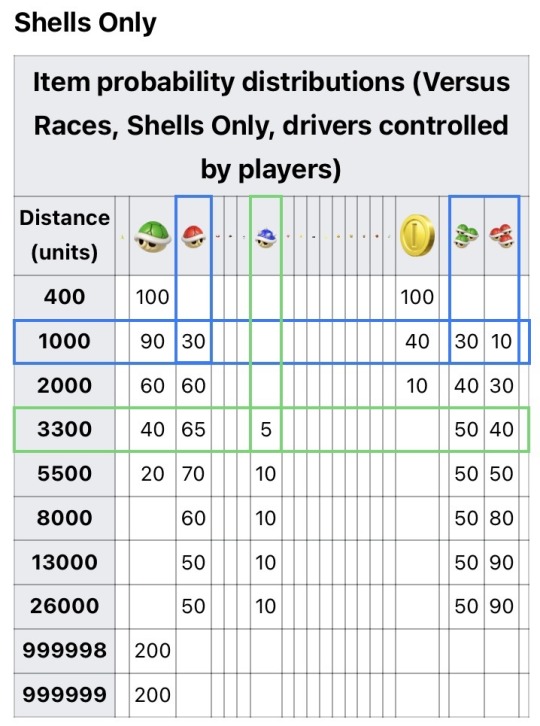
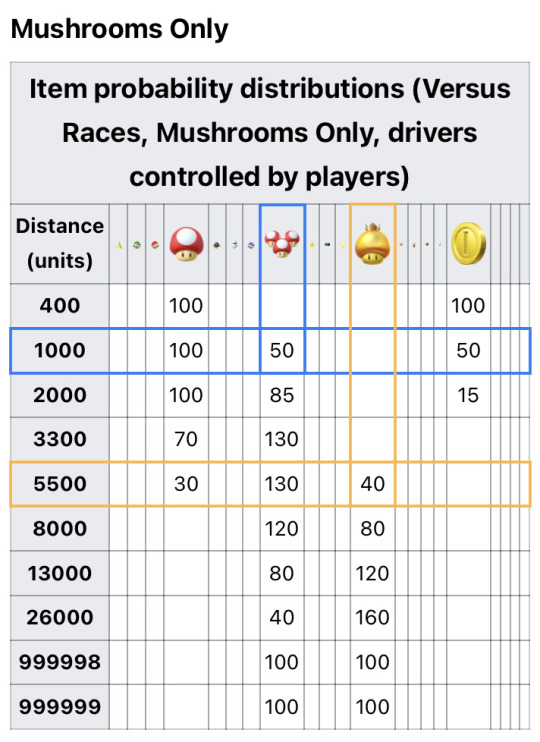
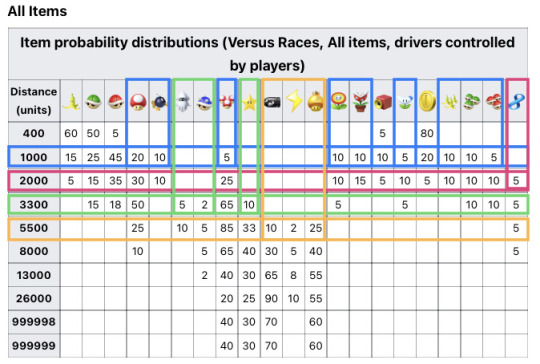
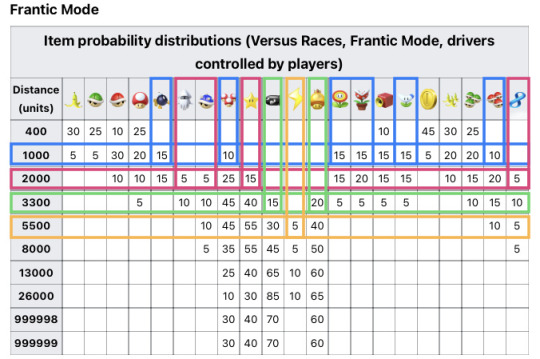
Once an item appeared after a certain amount of tries, check its related distance and try to drive back and forth from an apparent track line/current location to another apparent track line till the range tends to no difference (we can identify framed distances more easily using different item modes in favour of it).
Using given items' probabilities (see the charts above) to identify an estimate of a given distance in a given item mode.With the use of the Binomial law, we can consider stochastic variables (like X) associated with items to identify appearances in which trials' success corresponds to those items' presences.
To calculate the number of tries for getting at least one appearance of an item amongst the ones we have got to identify for a given framed distance, we have to solve for the number of trials after mathematically modeling our situation with probabilities :
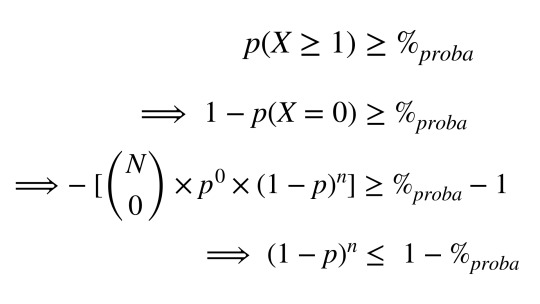

In our case, finding out the best item setting for each given distances (ranging from 1000 to 5500) with a wanted likelihood of appearance equivalent to 95% :
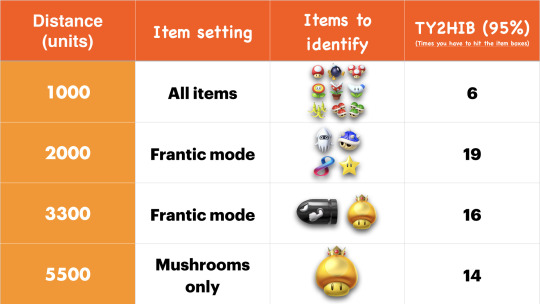
where :

Sum up all the track's section estimated distances to get the total distance.
Unfortunately, this approach only gives off framed estimates of distances and takes up way too much time & effort for something as uncertain as it is :/ . We'd have to be doing the track measurements in Mario Kart 8 Wii U version to avoid introducing conditional probabilities on top of assuming MK8 tracks are the same lengths as MK8DX tracks (plus, as the items' probabilities (charts) take into account Mario Kart 8 Wii U datas instead of Mario Kart 8 Deluxe's).
I know I did not elaborate much on this part and got a little quick but believe me it's absolutely not necessary to.
(Btw, see Mario Kart 8 items' probability distributions wiki to understand the probility system)
Let's now try out another way to determine ExciteBike arena's track length.
Firstly, we have to measure ExciteBike arena course's length.
Secondly, if we take a close look at Mario Kart 8 Deluxe player's statistics menu, we clearly see there is a traveled distance counter which displays this total traveled distance in kilometers (Km).
That means we can measure ExciteBike arena course's length but we have to do many races to get some decimal places out, doing the course over 100 times (driving in the middle of the road to get a fair estimate) should be enough for the experiments (a decameter accuracy is not a big deal simply because doing 1000 times a course to get a meter accuracy is useless since a few meters are negligible, e.g when you measure how tall you are you clearly not take millimeters into account as they almost make no signaficant differences to your height.. same goes for race tracks...)
Dividing the distance we obtain after 100 courses (took me about 3.5 hours straight btw) by 100 then by 3 (because there are 3 laps per course) indicates ExciteBike arena course's approximated length is 947 m (0.947 km).

Some people might be wondering why I do not use max speed values (in 150cc) from the Mario Kart 8 Deluxe wiki to determine ExciteBike arena's length in distance units but to my mind using undefined units (sorry not sorry but the wiki did not explained what a "distance unit" necessarily symbolizes in the game distance nor how it's been measured, same story with the "frame") for both distance and time isn't the best way to go for since those said values were provided by some people's tests not by developers themselves.Unless explained, we are not going to use distance units nor frames but rather in-game units for both distance and time (we'll be using the game's stopwatch in time trial mode).
Secondly, notice that the track consists of semi-cercles merged to a rectangle on each side of it like this :


We wanna apply pixel measurements to be able to quantify different proportions of the track :

Knowing the length of the used bars and using perimeter formulas we get the track's total length in pixels :

Then we have to take a specific portion of the track as long as possible with visually distinguishable eye marks from which we can get the experiments started (just as follows) :

To measure its length, we can place 2 players at both eye marks to determine the distance in-between the 2 players' map icons' barycenters in pixels (to make the barycenter thing easier, we only use Tanooki Mario's map icon since the shape is quite similar to a circle) :
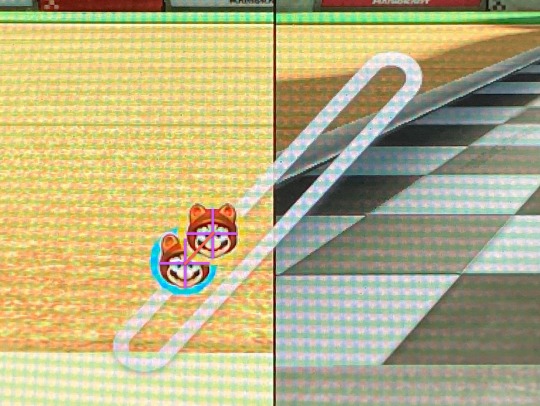

And get that length in meters too :

To set up the experiments, we have to take a combination with a level 10 of speed (3.25 speed stat bars), an average speed stat level combination :

We'll place the vehicle a certain amount of distance back from the first eye mark and make it use a mushroom to get to top speed quickly when its effect fades away while driving straight (no tilt to be as accurate as possible).Besides, we'll count the elapsed time using time trial's time display for 150cc & 200cc and external time counters for 50cc & 100cc (pardon the low quality) :
youtube
This way we can apply the average speed formula because the speed will remain constant during the tests, we can make a sequence of 20 values for each engine class (50cc, 100cc, 150cc & 200cc) and calculate top speed related to every single value :
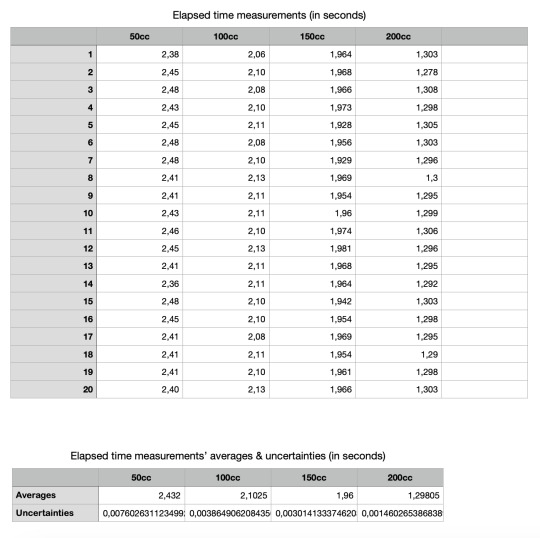

Eventually, we can average out the top speed values in real-life units for every engine class as follows :
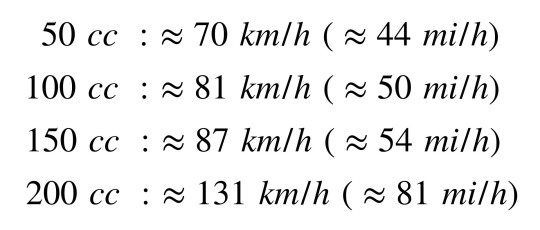
Suffice-it-to-say there are uncertainties but after correctly and identically performing experiments those shouldn't be a big problem, we could estimate those using variance and standard deviation :

So here we are with an interesting outlook on Mario karts' (bikes', ATVs' & all) top speed values (coinless), 200cc is just outrightly wicked fast irl (you'd definitely get pulled over in the motorway lol) :$
At least this info should calm down Mario Kart 8 Deluxe haters always obliviously claiming it's slow asf x)
Sidenote: For sUsSy BaKaS, We were obviously talking about ground speed (tbh I don't see people driving underwater, in anti-gravity nor airborne lol) as we tried to reach for a realistic approach.
Overall, all values are approximations (fair ones) but I curiously really wanted to get my hands on this topic as no one did it so far in the vast world that is internet :)
#mario kart 8 deluxe speed#mk8dx#mk8#mario kart 8#mario kart 8 deluxe#deep dive#deep thinking#gaming#video games#nintendo#mario kart 8 switch#mario#mario kart#mario kart 8 dlc#mario kart 8 deluxe real life speed#mario kart 8 deluxe velocity#maths#math#calculation
2 notes
·
View notes
Text

How to use coordinates in both Minecraft & Zelda Tears of The Kingdom?
Yep coordinates.. I did not expect it to be such an issue where many people still don't know how to use them to navigate around.
First things first, you have to know 3 dimensional space games have got 3 normal vectors (axises) constituting an orthonormal mark generally (cartesian) noted x, y and z respectively (by the way the x, y & z may be switched up as well as the orthonormal mark's direction).

In Minecraft, the x axis represents longitude (east or west), the y axis represents the altitude (upwards or downwards) and the z axis represents latitude (north or south).




In Zelda Tears of The Kingdom, the x axis represents longitude (east or west) as well, though the y axis represents latitude (north or south) and the z axis represents the altitude (upwards or downwards).


Now by using coordinates I imply using them to find back a location or go to a specific location (with coordinates) as quickly as possible.
So the following method actually regards for both games having a set position to go to only using your current coordinates:
# 1) Do not pay attention to the altitude coordinate.
It isn't really relevant, if you're going back to place you already know/visited, you'll eventually recognize & find the way to go on your own.
# 2) Fix the longitude coordinate value.
Get your longitude coordinate value as close as the one indicated for the place you wanna go to by moving around to decrease/increase your x value to reach for the final longitude value.
# 3) Fix the lattitude coordinate value.
Do the same for your lattitude value and try to keep your longitude value not changing too much (quite constant).
# 4) Fix the altitude coordinate value.
Once you fixed and got both longitude value & lattitude value stabilized enough, you can focus on the altitude value (if you still hadn't reconize the place or are exploring/visiting the place for your first time) move up or down depending on how high or deep the place is located.
Obviously, as you keep practicing you'll end up managing to fix the longitude value and almost at the the same time ;)
For example, if we want to get to a place located at (longitude : 342, latitude : 45, altitude : -98) while we are at (longitude : -22, attitude : 112, altitude : 402).
Move around and when we see the longitude value increasing, keep the direction we're going to until you reach for about 342.
Subsequently, while we keep our longitude value constant enough, we have to decrease our latitude value.Again, as soon as it's decreasing, we have to keep about the same direction till we reach for about 45.
Finally, with longitude and latitude coordinate fixed values, we only have to look get down to -98 in altitude (in our case it may be going down a cave/hill/cliff/path...).
So that's pretty much how to use coordinates in Minecraft & in Zelda Tears of The Kingdom, I hope it helps :p
Tip: In Zelda Tears of The Kingdom, you should set your mini-map pointing towards north in order to easily tell the direction you follow (at the moment) and travel throughout the world in a more simple way.
Sidenote: I know there might be some more optimized way to travel with coordinates from a location to another.
Nevertheless, I'm only basing these explanations from my experience and from what I judge optimal and efficient to be taught.
#minecraft#zelda tears of the kingdom#totk thoughts#ztotk#zeldablr#mineblr#deep thinking#deep dive#video games#gaming#mc#minecraft bedrock#minecraft java#java edition#bedrock edition#nintendo#sony#minecraft guide#minecraft oc#minecraft coordinates#totk#tears of the kingdom#tears of the kingdom coordinates#deep thoughts#zelda fandom#game guide
7 notes
·
View notes
Text

How much faster do we drive with coins ?
Every now and then, people tend to say: "yeah you get a 1% speed increase per coin you get so you get a 10% with 10 coins", "you a get a 1% speed increase per coin and a 15% speed increase with 10 coins plus a bonus speed increase" .....
Bla..bla.bla..bla.
Bonus speed increase.. a bonus of what is already a bonus.. seriously ?!
Okay so I know Mario Kart 8 deluxe has been around for the past 6 years now but we gotta discuss this topic ASAP because most players still have no clue of the true speed increase coins generate.
So according to the game itself, coins increase top speed.

The question is by how much is it increased ?
Well according to Mario Kart 8 Deluxe in-game statistics, the game indeed increases per coins you drive through (as you can see on this table) :

Basically it shows different top speeds values (in distance units/frame) for each level a combination accounts for its speed statistic (see this post to understand what a "level" is and represents) in every road section type you drive on (ground, water, anti-gravity, air).
Here is a simplified version of that same table so that everybody reads the values in an easier way :

From it, we understand each coin's top speed increase is in fact a flat increase which means that it's not a percentaged increase (a percentaged top speed increase would be relative and different for every level while a flat top speed increase means it's the same for every single level).
Now to find out the top speed increase we get 10 coins, we subtract the 0 coin top speed value to the 10 coin one for each level.Then we wanna know how it translates into a percentage.. However let me tell you right away, there is no such thing as "{insert number of coins} coin(s) increase(s) your top speed by {insert a percentage}", the top speed increase percentages are relative to a combination speed stat (even though they get the same amount of speed increment) meaning that we have to calculate these different percentages for each level of speed :



We notice that 10 coins increase top speed by 0.5 distance units/frame and that there is a 0.025 distance units/frame difference separating 2 level of speed.
Based off of this information, we can determine cumulative top speed increases for a given coin number (ranging from 0 to 10 as one should know) in distance units/frame, in levels & in stat bars :

Looking back into the top speed increase percentages, we see that it is more interesting and relevant for low speed combos to pick up coins than for high speed combos (in other words coins are more effective on slow combinations), I do not say it is unnecessary for fast combinations but it is only less efficient.
Ultimately, a coin increases your top speed by 0.628 % to 0.669 % (approximately) depending on your combo (you can get like up to 5 stat bars more for speed once you got 10 coins).Even though, their increases are lesser than expected, coins are still important.
Here is a side-by-side comparaison done by JPGiviner for us to visualize the actual differences :
youtube
Moreover, let's calculate the time difference between a 0 coin & 10 coin racers (i.e: how much time is the 0 coin racer late to the 10 coin racer at a given time) driving for a certain amount of time (of course we'll consider they are both driving straight at their top speed constantly) with both using the Mario/standard kart/standard wheels/super glider combo (speed level being 13) :

So we can chart every results out :

Finally, what you can remember is that for a 2 minutes of driving with Mario/standard kart/standard wheels/super glider, the 0 coin racer is about 8 seconds late to the 10 coin racer (note that this time difference gets shorter, the faster the combinations are)
Hence the outright importance of coins in Mario Kart 8 Deluxe performance talking :)
Sidenote: I didn't mention it but there isn't anything as a bonus top speed increase by picking the 10th coin, the coin counter getting orange doesn't imply a bonus top speed increase but is rather a game design choice to indicate the max amount of coins you could get in a race has been reached.
By the way, all the datas shown are related to the 150cc engine class.
#mario kart 8 deluxe#video games#gaming#deep thinking#deep dive#mario kart#mario kart 8 dlc#mario kart 8 deluxe dlc#mario kart 8#mario kart 8 coins#mario kart 8 deluxe switch#mario#mario kart 8 deluxe coins purpose#mk8#mk8dx#calculation#mario kart facts#nintendo switch#nintendo
1 note
·
View note
Text

What is Minecraft's gravitational constant value ?
This post is a follow up to this one, in which we found out Minecraft's acceleration due to gravity value :
When I say gravitational constant, I imply the one regarding players because it depends on the acceleration due to gravity which itself depends on entities in Minecraft (otherwise it's mostly inconsistant).
I'm not gonna lie this topic is way harder than its prequel, and I DID NOT see anything on the internet (not to say there isn't anything) talking about it (so if you wanna argue on smth pls source what your saying).. actually nobody really searched for Minecraft's gravitational constant value.
So here we are looking into that.
First of all, one thing to know is that a Minecraft world spreads over 30 million blocks in each direction of the orthonormal basis (here I'm referring to absolute distances) in 2 dimensions (in every direction except in altitude) :

From this we can calculate the area from a square-like perspective :

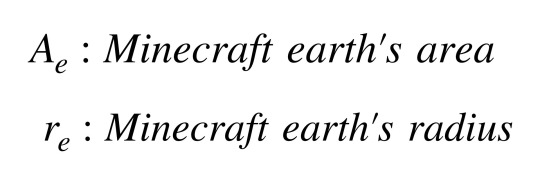

Now most people assume Minecraft´s earth to be a cubic planet but this would mean that a player falling from a certain height get a different falling time depending on the place you are (on corners especially).
After testing it out, I ended up noticing a player's falling time is approximately the same regardless of the place you fall from (from a given height) which only means one thing, Minecraft earth is a spherical planet (might sound very odd to you but it is indeed logical).
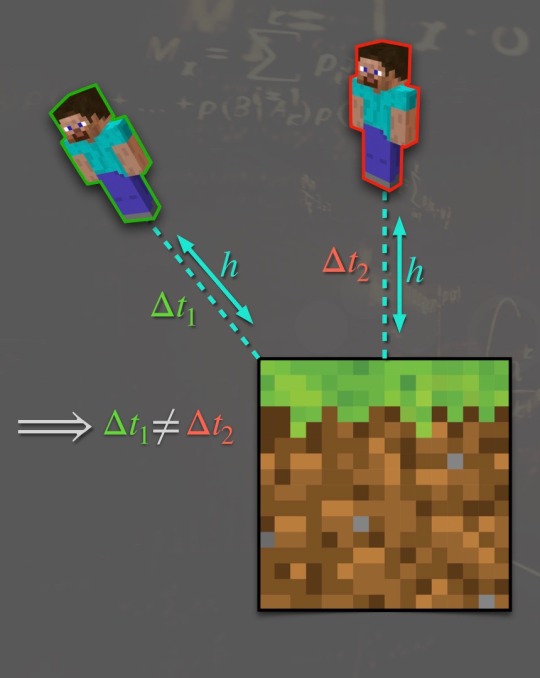
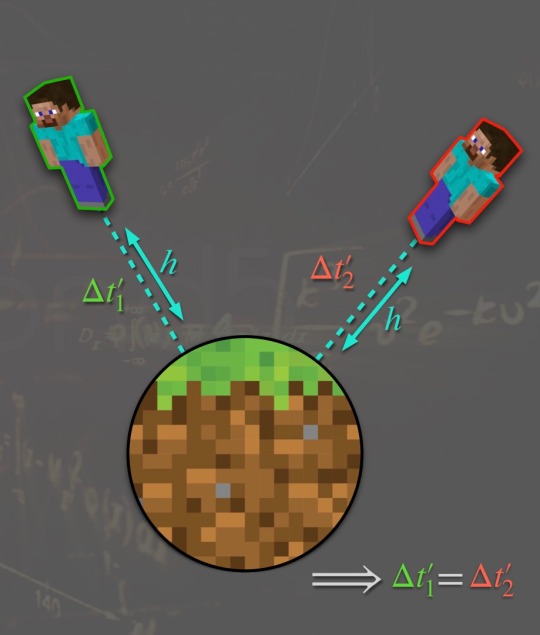
Besides, using the area we calculated and the sphere area formula, we can solve for the radius :
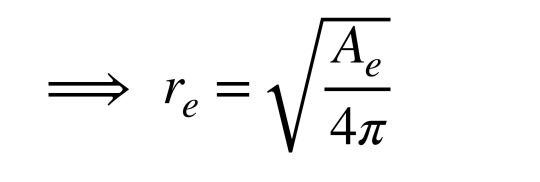

Since we have got both Minecraft earth's radius & Minecraft's acceleration due to gravity value, we can (re)try to use Newton's law of attraction :
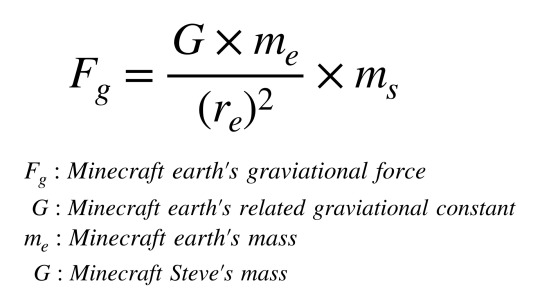
Then after simplifying and solving for the gravitational constant with Newton's second law of motion, we still gotta figure out Minecraft's planet's density (as we can determine the volume, it's better to search for density rather than mass).
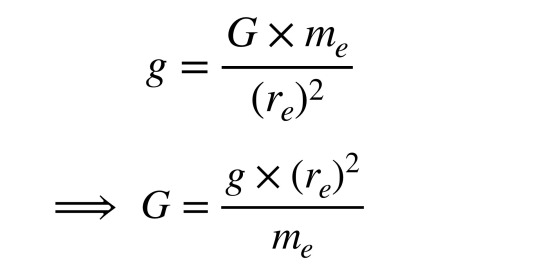
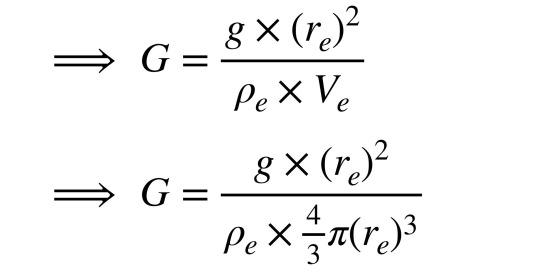
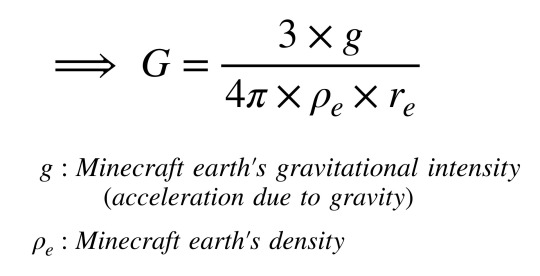
Unfortunately, substituting formulas in equations, making linear systems, the gravitational constant as well as the density always checked out :(
Even after introducing more formulas (like the kappa formula or the escape velocity formula) it couldn't be any more relevant :/
There seems to be something wrong but long after hours upon hours of researches (and dozen liters of sweat that could fulfill a whole swimming pool lol) I realised we could proceed by identification going back to this formula :

A product of 2 unknowns equals a constant (as g and the radius are known).. interesting...
Guess what, in order to proceed by identification, let's dispatch known parameters and constants as well :

Let's now see the numerical approximations of each physical quantities using real-world values beforehand :

Okay so what's important is to look at the scale order of the inverse of the radius, it's a 10^-7 order and it's pretty close to the actual universe's gravitational constant standing with a 10^-11 scale order.
So let us add a 10^3/10^3 in the following way :
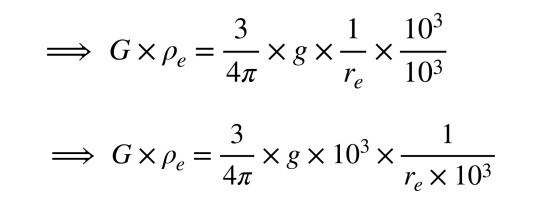
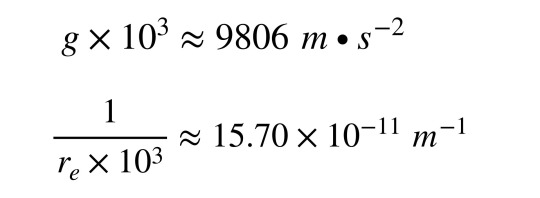
We get to see that 1/(radius*10^3) has got (practically) a scale order of 10^-11.. we're steadily stepping towards the answer guys : )
I also want to point out g*10^3 and density p (rho) scale orders are even.
Which in fact means :

where :

If we break down π into sqrt(π) * sqrt(π) in this manner we get :

with :

Consequently, applying numerical values related to our real-life solar system & earth results in values infinitesimally nearing the actual approxs (it's demonstrated through relative gap calculations being less than 1 %) ;)

hence :
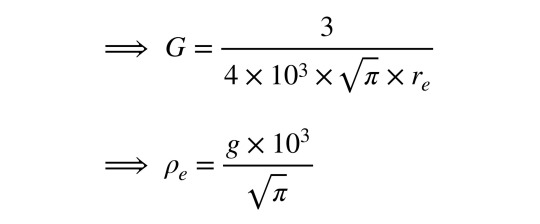
respective relative gaps :

Furthermore, since we study Minecraft's earth planet, we can use the previous final formulas to calculate approximations of both Minecraft's planet related gravitational constant value and density value (as Minecraft suggests a similar solar system to ours in which its earth belongs in) :

Okay we got what we wanted, but let me suggest you a quick understanding to check the coherence of our results.
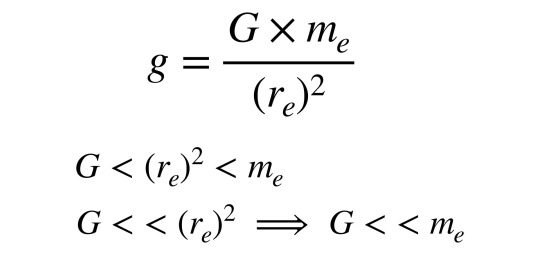
Take a close a look at that formula identified from Newton's law of attraction, we know G (gravitational constant) tends to zero (its value is so small it´s almost zero: about 6.67*10^-11 m^3 • s^-2 • kg^-1) and the radius being a large number.In order to get a final value greater than 1, earth's mass have got to be really large & so the density.
In the case of Minecraft, as the radius is larger and we know the overall division value is approximately 3.23 greater than the real-life one which makes it obvious Minecraft earth's mass, density & volume are greater for sure.
So that's pretty much what we had to do to get an approx of Minecraft planet's related gravitational constant.
Sidenote: It's just a hypothesis, I wanted to make something plausible, cuz assuming our earth's properties to make calculations haven't really satisfied me and isn't correct to apply in a video game (plus people making these assumptions usually don't explain why they use them for a given case).
Also, I'm aware the units aren't possibly correct but all you need is a reference value which wouldn't change the results (1.0 {insert appropriate unit} ) with units making up for the wrong ones.
Edit: For sussy bakas, I solved the whole thing symbolically at first and only (purposefully) numerically displayed intermediate results to picture a significant value but didn't till the final results offline :p
#minecraft gravitational constant#gaming#deep thinking#video games#mineblr#mc#minecraft bedrock#bedrock edition#java edition#deep dive#deep thoughts#nintendo#sony#minecraft steve#minecraft#minecraft oc#science#physics#minecraft java#maths#math#gravitational constant#gravity#minecraft gravity#minecraft gravitation constant value#calculation
78 notes
·
View notes
Text

How do stats work in Mario Kart 8 deluxe ?
They're many people hopping on Mario Kart 8 deluxe without necessarily understanding how do statistics work.
I know the post's headline may lead to some misconceptions so let's directly set things up.I'm not talking about the signification of each & every single stat (i.e. what acceleration represents in a vehicle combination nor how it affects one), but rather about where the numbers/stat levels come from.
Like previous Mario Kart games, this game in the vehicle customization screen if you press either + or - button, the current vehicle combination's statistics screen shows.In which you can see your combo's stats and how it allocates quantitatively speaking.
In Mario Kart 8 Deluxe, a combination's stats are displayed through bars, there are 6 bars in total increasing or decreasing by quarter bars (the amount of bars generally ranges from 0.75 to 5.75).

Now this is what the basic information game shows you, however according to Mario kart 8 Deluxe wiki page characters' and vehicle parts' statistics are intrinsicly given "points" for each stat.The sum of each combination's parts' points constituate what is called a level.
In fact, these levels range from 0 to 20 meaning there 21 levels in total.
You might be wondering how do those said levels translate into bars ?
Well.. let me explain, for a given stat the game takes your vehicle parts' statistics & character's points to sum them all together your combo's level, the game subsequently adds 3 points and divides the sum of your combo's total points (level) plus 3 by 4.

For instance if we take Mario/standard kart/standard wheels/super glider ( you know the starter pack of every people that never played any Mario Kart game before on top of not knowing any characters/vehicle parts beside Mario x] ) and try to determine the combination's ground speed stat amount of bars knowing :

We just have to do the following calculation :

So we got 4 bars of ground speed, let's check our answer using Mario Kart 8 Deluxe builder :

We indeed got the right amount of bars regarding ground speed.
With the easy part out of the way, we have to jump into into the more difficul'.. I mean the more interesting part.
First of all with what we currently know, we can modelise the level-bar translation using the next mathematical function :

Simplifying the function makes us realize we face an affin function which implies a linear function which actually implies a proportionnality bewteen levels and bars.

Studying the function with x takes integer values ranging from 0 to 20 confirms the fact that the amount of bars for a given stat ranges from 0.75 to 5.75, as you can see down below :

Then, setting a linear regression features up the fact that levels and bars are proportional (the proportionality factor being 0.25 like the mathematical function suggests).In other words, we notice that this proportionality factor represents the increasing/decreasing one fourth step hence it moving by quarters.

We basically figured out what most MK8DX players wouldn't even bother paying the slightest ever attention possible lol, demonstrating a visual evidence topped off with a creamy explanation :p
Sidenote: If you see thumbnails showing an amount of stat bars lesser than 0.75 or greater than 5.75, that is literal cheater material right there for sure ;)
#mario kart statistics#mario kart#mario#gaming#deep thinking#deep dive#mario kart 8 dlc#video games#mario kart 8 switch#mario kart 8#super mario#mario nintendo#nintendo#nintendo switch#mario kart 8 deluxe stats#mario kart 8 deluxe#mario oc#mk8dx#mk8#calculation
0 notes
Text

Have you ever wondered what is the value of Minecraft world's acceleration due to gravity ?
First off, we have to clear something up, when I say Minecraft world's acceleration due to gravity, I imply the one from players' perspective because it may vary depending on the regarded entity (you might have noticed that a player falls down faster than a zombie for example).
Let's now define what is acceleration due to gravity aka gravitational Intensity.
Acceleration due to gravity is basically the acceleration gained by an object due to the gravitational force of attraction. It has got both magnitude and direction, and is represented by the letter g.
Many people tried figuring out Minecraft world's acceleration due to gravity g.However there was so many misconceptions (sometimes) and uncertainties with big gaps among claimed results (non exhaustive list) :
Nameless88 found g ≃ 23.31 m/s^2 ; Nathiuz found g ≃ 13.88... m/s^2 and g ≃ 2.609... m/s^2 ; y2bd found g ≃ 18 m/s^2 ; etc...
But amongst people who tried doing experiments, neglecting some parametres such as especially air frictions which represents their experiments' main flaw, most people that tested it out with experiments (nothing wrong with that scientifically speaking) which in theirselves contain uncertainties but the way they were doing it was pretty much different hence the large panel of diverse results.
So in this post we're gonna end the debate geared around Minecraft world's acceleration due to gravity value going around for over a decade now :p .
First things first, Minecraft is game, which means it's been coded, programmed visually, {insert an adjective qualifying Minecraft game}-ically, but also scientifically (mathematically/physically).I mean the game is suited to certain logic.
That means there are some parts of Minecraft's code defining Minecraft world's gravitational Intensity.
This means by extension that if we happen to find them we could find out the gravitational intensity without doing any experiements nor getting any systematic inaccuracies/uncertainties.
Our goal is to study a research worthy case along with the least amount of variables , so we are going to study a player's free fall of from a certain height.
Keep in mind that when you're falling, the falling velocity is getting faster and accelerates until you feel like you're falling more slowly meaning you hit terminal velocity and stopped accelerating (notice your skin's arm if you enabled skin animations).
In fact, according to the Minecraft fandom wiki reveals that there is a mathematical function associated to the speed of a free falling player :

By property, speed is the derivative of acceleration initially, we can get to find Minecraft world's acceleration due to gravity.
Unfortunately, the floor function isn't differentiable at 0 knowing it is discontinuous.Nonetheless, we also know 20 t is floored because Minecraft updates once each tick, and we're trying to find out the acceleration of a player's free fall motion (the function's derivative): When a player starts to free fall, the initial moment is at t=0.This would logically mean the game still hasn't start to update the first tick (1/20 s) once.
That basically suggests with no time update once a tick we drop the floor function and use the following continuous function to calculate its derivative at 0 :

Let's differentiate this function (I'll detail the steps for people that wanna understand where it comes from instead of just throwing the final results at them :] ) :
# 1) Adapting the function expression to find its derivative more easily:

# 2) Differentiating the function to express its derivative:

# 3) Recall this formula:

# 4) Finally, to determine the acceleration due to gravity, we only have to calculate a player's free falling acceleration at t=0:

(We negative out a(0) cuz 0.98 < 1 => ln(0.98) < 0 and when a player free falls, it's a downward motion)
There we have it guys.. the Minecraft world's acceleration due to gravity value which is about 3.23 times the actual earth's one :o .
We definitely decreased room for inaccuracies by literally taking an in-game function to get a somewhat acceptable result.
I crunchyfield officially end the debate in 2023 (any questions, wanna point out mistakes: tell me everything here :p).
Sidenote: Afterwards, we are able to determine Minecraft world's gravitational constant (for another post), or Steve's weight (w = m • g = 375 x 31.7 ≈ 11 876 N).
I highly advise you to take a look at this post to understand Steve's weight :
Edit: I used the right amount of significant figures for the final result this time around to leave the post peacefully physics wise :)
#minecraft#minecraft gravitational intensity#minecraft acceleration due to gravity#gaming#mc#minecraft oc#video games#mineblr#minecraft java#minecraft aesthetic#minecraft bedrock#minecraft steve#deep dive#deep thinking#physics#maths#math#bedrock edition#java edition#sony#nintendo#calculation
4 notes
·
View notes
Text

What's Link's height in Zelda Breath of the Wild ?
Most players tend to say that Link's height ranges from 4'10" (1.47 m) to 5'7" (1.70 m), assuming he is short in our reality scale as well.
What if I told you this is not the case, what if Link was actually tall ? What if I told you creatures/entities are just freaks of nature in Hyrule kingdom ?
This topic is a quite recurrent one regarding any Zelda game which has been discussed many times but I'd like to give an insight on it tbh :)
As always several methods were used nonetheless only one stood out of the happy internet :
youtube
Overall, Bread Pirate's method seems good using an external tool which consideres one unit (in terms of distances & coordinates) in ZBOTW memory editor equates one meter finding out Link is 1.584 m tall (5'2").He didn't take the perspective distortion (parallax) into account since link was standing a certain amount of distance back while measuring the metal box in front meaning that he may end up being taller.
I honestly believe we could get Link's height in other way.
But throughout our researches we have to proceed from a in-game defined fact and try not to use any assumptions that could lead to unnecessary uncertainties.
Note: We gotta be careful of how we use or/and make assumptions since worked out in a wrong way it'd probably lead to sussy results or totally mess up the final results.
Traveling through Hyrule kingdom and talking to different characters/NPCs, We can identify some crunchy info, especially in Gerudo town where we can talk to Deltan (you know the hunched over gerudo crying at the bar about {something I don't have the energy mentioning because I'm not a psychologist nor somebody who likes getting himself in stories he doesn't belong in} related to her past love relationship) who eventually ends up telling us she is 8 feet tall :
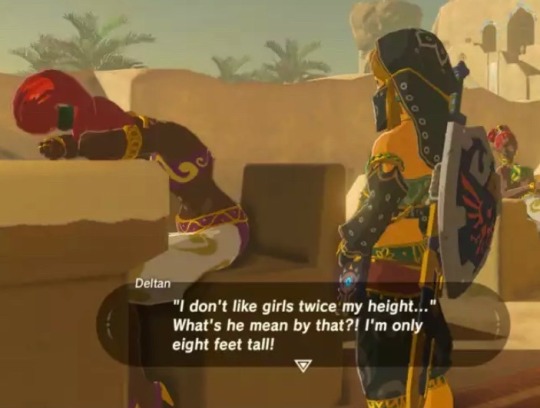
(I tried reading the dialogue in multiple languages but nothing very relevant beside in English, she just says that the dude who turned her down was 3 heads (might be gerudo heads as it stays her perspective) shorter than her).
So Deltan being 8 feet is our in-game canonical fact (average adult female gerudo Deltan-like in-game canon height), notice that Deltan is an adult female gerudo specifically and as you might have noticed there are different gerudo's height categories (non exhaustive representations) :
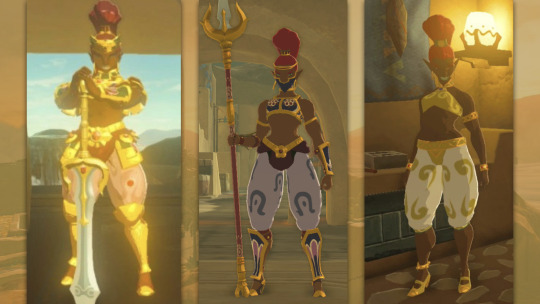
Moreover, we know Deltan is gerudo villager not warrior, it's really important to differentiate gerudo villagers & gerudo warriors.Indeed, they present different heights where one is a shorter than the other respectively.
Keep in mind that they may seem tall to players but are not all equally tall.
Now the next step is to find an adult female gerudo similar to Deltan in the straightest stance on a flat enough surface.To do so we could check in Kara Kara Bazaar but there aren't too much flat surfaces, checking in Gerudo town though we can see the gerudo named Frelly who offers morse-like (I forgot about the name of the ZBOTW specie) rides for a certain amount of rupees.
Problem: She keeps moving her body and clapping her hands x) , I know business is business but empirical game knowledge is a better business lmao.
Almighty solution: To get her to a straight stance we have to hit her, yes gotta hit her for not standing straight x) .
After taking a couple dozens of pictures, here is the one which is to my mind the most accurate one for the height comparaison experiment (do not pay too much attention to the low image resolution) :

Let's apply pixel measurements to get proportions.We basically wanna measure link from a bit higher than his left foot at the front so that it matches the level of the gerudo right foot in front and to avoid as much perspective distortion as possible.
We measure Link all the way up his body till a tiny bit lower than his head to get his true height without taking too much of his hair & white veil into account.
Regarding Frelly, she'll be measured up to her head but we'll also subtract her heels' height to her total height (because you know people aren't measured with heels nor with big haircuts lol) :

Finally doing quick maths we get Link's height :

Unexpectedly, Link is surprisingly very tall, don't get me wrong, he looks short for sure relatively to his world.
People really need to stop assuming realistic games fit reality height scales because in Zelda Breath of the Wild Hylians are just giants which means that overall monsters, men, women, entities, vegetables, mushrooms etc.. do not fit our world average height scales by any means.
That being said, Link turns out being pretty tall in our world scale and towers over most humans in terms of height so we now know that he isn't as short as people in the community thought.
It's indeed unbelievable that Link is actually taller than many of us but this theory is based off of an in-game reference unlike other ones which makes it worthy to vouch for to be fair ;)
Sidenote: I obviously made ton of measurements where height ranged most of the experiments from 6'1" (1.85 m) at least to 6'5" (1.95 m) at most and would results should stay in-between this range even trying yourself.
Edit: Doing accurate measurements gives a margin of error of ± 0.01 m (about ± 0.004 in) for ZBOTW Link's height.
#Link's height#zelda breath of the wild#deep thinking#deep dive#breath of the wild#botw zelda#link#zelda#zelda fandom#link botw#zelda botw#botw link#the legend of zelda#zeldablr#gaming#video games#nintendo#gerudo height#botw link height#zbotw link height#botw theory#totk#totk theory#zelda tears of the kingdom#calculation#loz link#loz breath of the wild#loz tears of the kingdom#loz botw#height
4 notes
·
View notes
Text

Have you ever wondered what's the mass of our friendly Steve ?
Well what I could tell you is that he for sure weighs more than some random apples but how heavy is he actually because as we discussed Steve's height in a previous post, let's now figure out his mass.
(yeah I said mass not weight because weight is in this case the force of attraction exercised between Steve at Earth's surface level and Earth's core level which is different)
The topic has already been thought out in the article thereafter:
However I strongly disagree with it assuming blocks' voxels' (3D pixels in Minecraft) dimensions are equivalent to Steve's voxels' ones when stating that Steve weighs 342 kg (754 lbs).It's just not necessarily true, in fact a mob's voxels' dimensions are subjective.
First off, we know Steve is 1.875 m (6'2") tall and measures 32 of his voxels in height that we'll shorten as svx (Steve voxel(s)) as of now for the sake of simplification.
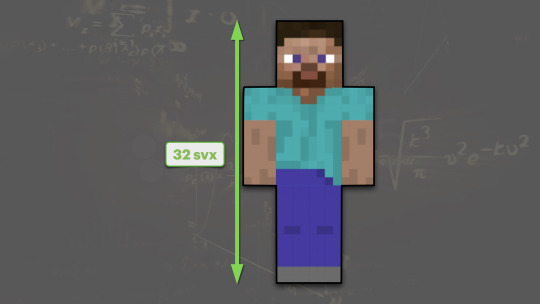
With this out of the way, we have to find Steve's total body volume, to proceed we can notice Steve's character model could be viewed as 2 rectangular parallelepipeds & 1 cube attached all together :p .
This means means that we'd have to sum every 3 volumes to find out Steve's total body volume.
To proceed we can display some 3D axes non orthonormed for each volume to get a clear sight of what we're trying to measure as such:
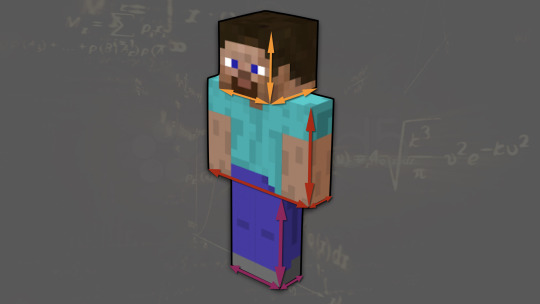
Now as you might think, it's indeed a bit tough to clearly count voxels so let's make the task easier by counting voxels on a modified Steve skin:


Here are the results:

Thus Steve's total body volume corresponds to :

Now keep in mind that a svx equates :

which is about :

Finally we can translate Steve's total volume in cubic meters :

Furthermore, since Steve is a very athletic character (he jumps all the time, run all the time, looks healthy & is most certainly not average at all) we'll assume his body fat percentage to be approximately 10%.
After asking a few stupid questions to ChatGPT AI we're gonna assume Steve's body density is similar to an average low body fat, athletic (and ripped ofc x] ) male body density whose value is 1120 g/m^3.



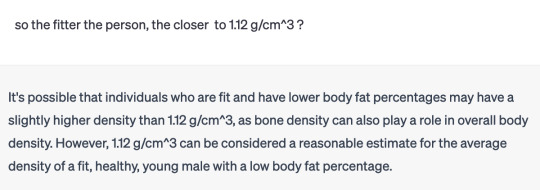
As a result, manoeuvering the density formula gives a way to calculate Steve's mass :

Basically this guy is huge in every direction lol, his BMI is tremendously over 30 BUT we cannot necessarily say that he is morbidly obese because he does not look like it and if we were to make any judgement, those must be based off of Minecraft's world properties not of our world's...
Sidenote: Don't try to sue me for not getting the significant figures right, I purposefully let more decimal places to show how results really go.
#minecraft#steve's mass#steve's weight#heavy steve#gaming#mc#minecraft oc#video games#terraria#mineblr#minecraft java#minecraft aesthetic#minecraft bedrock#minecraft steve#bedrock edition#java edition#deep dive#deep thinking#sony#nintendo#steve weight#steve minecraft#minecraft steve weight#calculation
9 notes
·
View notes
Text

What's Steve's height in minecraft ?
Many people thought steve was about 5'6"(1.68 m), 5'7"(1.70 m), 5'8"(1.73 m) , 5'11"(1.8 m) or even about 2.0 m (6'7").
Guess what, some even tried to measure him according to his hitbox (it's like measuring yourself up to a tad bit higher than your eyes considering the remaining part of your head would be irrelevant somehow lol).
Several methods were used many of which carried inaccuracies along thus resulting in Steve's height ranging from short guy below average to tall guy above average (like what ? why so much difference ?), I quote the F3 method :p .
So let's clear all that out once and for all.
First and foremost, one random civilized Minecraft player should know by now that a Minecraft block is 1.0 cubed meter (as stated by Mojang years ago) meaning that it's 1.0 meter high, on top of this a block is 16 voxels high (Minecraft 3D pixels).
This also means a voxel equates 0.0625 m.Then knowing that info, invites us to think of how many voxels exactly is Steve next to a 1 x 2 wall.

As we can see, Steve visually appears to be 2 voxels smaller than a 1 x 2 wall (indicating Steve is 30 voxels high) but before going any further with this assumption, we have to check its reliability first by calculating the relative gap using pixel measurements:

Since the relative gap is lesser than 0.05 % (that's crazy clean not gonna lie here) , we can now freely assume that Steve is indeed 30 voxels high and doing quick maths we get his actual height:

All in all, Steve happens to be pretty tall & above average with an outstanding height of 1.875 m (6'2").
Unfortunately, this remains not that tall in comparaison to other mobs such as villagers being 2.0 m (6'7") or like husks being 2.125 m (7'0") for instances.
Sidenote: It has been officially stated for a while that Steve is this tall which by the way makes my post seem to be more of a demonstration though x) .
Fun fact: For all the sussy bakas still wondering, since Steve is officially 1.875 meters (6'2") it means that a block is most certainly 1.0 cubed meter.
#minecraft#steve#steve's height#minecraft bedrock#minecraft java#gaming#video games#mineblr#deep thinking#deep dive#mc#steve minecraft#minecraft oc#minecraft aesthetic#bedrock edition#java edition#sony#nintendo#minecraft steve#steve height#minecraft steve height#calculation
6 notes
·
View notes